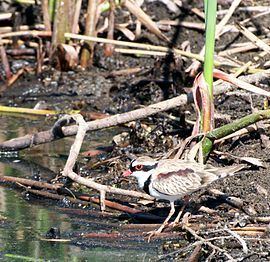Nearest town or city Brewarrina Visitation Closed to the public | Established October 1988 (1988-10) Area 264.8 km² | |
 | ||
Managing authorities Website Narran Lakes Nature Reserve See also Protected areas ofNew South Wales | ||
The Narran Wetlands, also known as the Narran Lakes, contained within the Narran Lakes Nature Reserve, comprise a series of protected ephemeral lakes and swamps fed by the Narran River in the north-west of New South Wales, Australia. The 26,480-hectare (65,400-acre) reserve is located approximately 50 kilometres (31 mi) east of Brewarrina.
Contents
Map of Narran Lake NSW 2839, Australia
An 8,447-hectare (20,870-acre) area contained within the reserve is protected under the Ramsar Convention as a wetland of international importance. It is internationally important because of its rarity and naturalness; its significance for waterbirds, supporting large colonial waterbird breeding events of ibis, spoonbills and cormorants; and its importance as a drought refuge for waterbirds. The vegetation and the waterbird colonies are at risk from reduced flooding caused by upstream water abstraction for agriculture in Queensland.
Description
The wetland complex formed by the Narran floodplain is the terminal system of the Narran River, the easternmost distributary of the Balonne River, and lies between the towns of Brewarrina and Walgett, in the Murray-Darling Basin. The floodplain contains three areas of open water, Clear Lake and Back Lake (with Long Arm) in the north, and Narran Lake (also known as Terewah) in the south, connected by expanses of vegetation subject to flooding. The wetland supports extensive and dense stands of lignum with, in places, an overstorey of river red gums or belalie. The vegetation constitutes the substrate on which the waterbird breeding colonies depend and which require regular flooding for their survival. The average annual rainfall is 495 millimetres (19.5 in). The surrounding region is part of the semi-arid pastoral zone used mainly for grazing cattle and sheep.
Birds
The wetlands have been identified by BirdLife International as an Important Bird Area because they support large numbers of nesting waterbirds when flooded. Birds include the largest colony of straw-necked ibises (with up to 200,000 pairs), over 1% of the world populations of Australian pelicans and black-fronted dotterels, and small numbers of endangered Australasian bitterns. Other birds which have been recorded in relatively large numbers include pied, little black and great cormorants, freckled and pink-eared ducks, black swans, glossy ibises, whiskered terns, royal spoonbills and darters.
